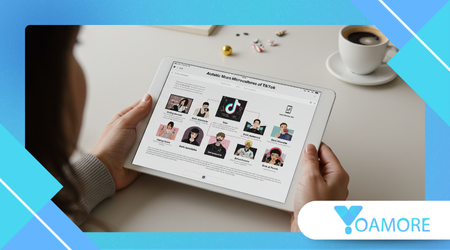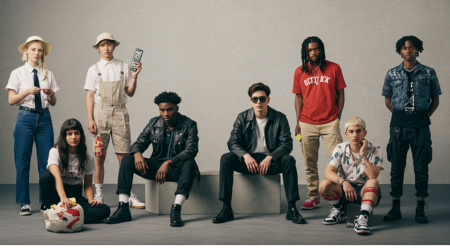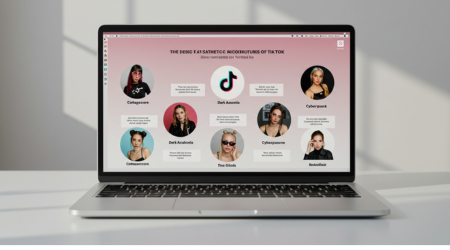The Aesthetic Microcultures of TikTok Explained

The aesthetic microcultures of TikTok have evolved far beyond fleeting visual trends—they’re now digital symbols of identity, escapism, and cultural resistance.
Anúncios
In a world that feels increasingly chaotic, these niche aesthetics offer users a sense of belonging without the burden of explanation.
In this article, we’ll break down how these microcultures form, what they represent, and why brands, creators, and even social scientists should be paying close attention in 2025.
Microcultures as Modern Language: More Than Just a Look
Scrolling through TikTok today feels like flipping through dozens of hyper-stylized diaries.
From “Weird Girl Aesthetic” to “Eclectic Academia,” each aesthetic is an unspoken language.
Anúncios
Users don’t just wear these styles—they live them, express emotional states through them, and often find their tribe via these digital visuals.
In 2025, these aesthetic microcultures of TikTok have become semiotic playgrounds. It’s not just a hair clip or a color palette—it’s signaling.
For instance, a muted-toned video with oatmilk lattes, unread hardcovers, and soft jazz in the background might communicate “emotionally guarded but intellectually open.”
These digital visuals communicate values quicker than words ever could. And that’s not accidental—it’s design powered by emotion and the platform’s intuitive interface.
Also Read: The Tuvan Throat-Singing Language and Its Cultural Soundscape
The Algorithm Behind Belonging

TikTok’s algorithm doesn’t just deliver what users want—it anticipates what they might need. That emotional intelligence, though artificial, is what allows these microcultures to grow fast and feel deeply personal.
Unlike other platforms where hashtags or forums used to bind communities, TikTok cultivates aesthetic groups through content loops.
A single edit, audio snippet, or outfit combination can spiral into a fully formed aesthetic in just days.
According to GlobalWebIndex and Statista, 70% of Gen Z users in 2024 reported discovering new personal styles, life philosophies, or emotional narratives through TikTok before engaging with them on any other social network.
So, what begins as a visual cue often blossoms into a lifestyle. That’s the real magic of these microcultures—they evolve alongside the user.
Also Read: Can Emoji Become a Real Language?
Identity Through Vibe, Not Labels

In previous generations, subcultures demanded allegiance—punks, goths, preps. Now, we live in a time where identity is more fluid and experimental. TikTok aesthetics reflect this new paradigm.
You don’t need to fully subscribe to Cottagecore or Clean Girl. You can flirt with both. You can dip into Goth Renaissance on Monday and switch to Liminal Spaces by Wednesday.
These aesthetic microcultures of TikTok allow users to explore facets of themselves without committing to rigid social labels. It’s expressive, freeing, and uniquely suited to the generational shift toward mental wellness and emotional openness.
In this way, TikTok becomes more than a feed—it’s a sandbox of selves.
Aesthetic Experimentation as Self-Therapy
What’s the link between these visual trends and mental health? Surprisingly, a strong one.
During pandemic lockdowns, young people turned to aesthetic building as a form of digital therapy.
Reimagining your space with LED lights or curating moody edits became a way to assert control over an uncertain world.
This didn’t end with quarantine. In fact, it’s intensified. In early 2024, TikTok saw a resurgence of “comfort aesthetics”—like Aquariumcore and Post-Anime Serenity—that reflected collective fatigue and emotional disconnection. These weren’t fashion statements; they were visual prescriptions.
When creators post routines wrapped in Soft Girl ambiance or reclaim messiness through Goblincore, they’re not just broadcasting—they’re self-soothing in public.
The soothing loop of a slow morning, filmed with ambient sound and natural light, functions like a modern-day mantra. It calms. It connects.
Original Case: The Rise of “Finance Bro Minimalism”
One of the more surprising microcultures to emerge in 2024 is what users dubbed “Finance Bro Minimalism.”
It features charcoal color schemes, minimal decor, time-blocked calendars, and espresso rituals—all framed as productivity porn.
But underneath the sharp visuals lies something deeper: anxiety about performance, success, and being left behind. It’s an aesthetic of control—expressed not in abundance, but in curation.
Creators embracing this aesthetic aren’t just showing off habits; they’re signaling stability in an unstable economic climate.
With student debt rising again in 2025 and remote work reshaping career paths, this microculture is part therapy, part branding.
It’s a clear example of how the aesthetic microcultures of TikTok often encode economic pressure into beauty.
Design Meets Philosophy: When Visuals Become Values
Another reason these microcultures stick is because they align visuals with deeper values.
Take “Eco-Witch Aesthetic,” a blend of green tones, moon rituals, herbalism, and upcycled fashion. It’s not just a style—it reflects environmentalism, feminism, and anti-capitalist thought.
Or consider “Digital Decay,” a moody blend of broken tech, VHS filters, and existential quotes. Its message? Resistance to hyper-optimization and over-automation.
In 2025, these microcultures are how younger users negotiate their place in a world dominated by surveillance capitalism and algorithmic fatigue.
They’re aesthetic shields—beautiful, coded, and often defiant.
An Analogy Worth Considering
Think of these aesthetics as modern-day “mood rings.” Just like a mood ring responds to your temperature, these microcultures shift based on emotional, social, and political climates.
In 2023, Corecore emerged as a chaotic montage aesthetic to express collective burnout. By early 2025, it evolved into “Dreamcore,” a softer cousin signaling disconnection and digital disillusionment.
Mood rings didn’t just look pretty—they indicated change. And so do TikTok aesthetics.
What Brands and Marketers Must Understand
Many brands fall into the trap of surface mimicry—copying the visual cues of a trend without understanding its emotional core. This often backfires, leading to distrust and digital backlash.
However, brands that listen and co-create with creators inside these communities can build authentic engagement.
Diesel’s 2024 campaign co-created with “Trash Glam” creators resulted in viral success because it amplified the aesthetic instead of exploiting it.
For deeper success, brands need aesthetic fluency—not just trend awareness.
TikTok’s Role as a Cultural Engine
More than just a social platform, TikTok has become a cultural seismograph. It picks up tiny tremors of emotional and stylistic change long before other platforms.
According to the MIT Technology Review, TikTok is “where Gen Z builds identity, not just displays it.” This ability to create, modify, and dissolve identities visually is what makes the platform revolutionary.
It’s less about virality and more about vulnerability, taste, and experimentation. TikTok allows people to be witnessed—and to witness others—in highly curated emotional ecosystems.
Why These Microcultures Matter in 2025
We live in an era defined by fragmentation—media, identity, politics. In this fragmented reality, aesthetic microcultures provide a kind of narrative glue.
They don’t fix the chaos. But they give it a frame. A filter. A way to hold something fleeting and make it feel like it matters.
Whether it’s a camera angle, a chosen font, or a wistful soundtrack, users construct meaning—one aesthetic detail at a time.
The aesthetic microcultures of TikTok are emotional blueprints for digital life. They’re our silent poems, our messy declarations, our curated cries for connection.
Frequently Asked Questions (FAQ)
1. Are aesthetic microcultures the same as visual trends?
Not quite. While trends come and go, microcultures have emotional resonance, visual grammar, and values behind them. They often survive longer and evolve over time.
2. How do these microcultures form so quickly?
Thanks to TikTok’s hyper-personalized algorithm, a single visual or audio cue can scale rapidly. What starts in one corner of TikTok can become a microculture in days.
3. Do people follow only one aesthetic?
No. Most users blend, shift, and evolve across aesthetics based on life phase, mood, or inspiration. That flexibility is part of the appeal.
4. Do aesthetics influence real-world behavior?
Absolutely. Many users report changing their routines, spending habits, fashion choices, and even worldview after engaging with certain microcultures.
5. Where can I learn more about evolving aesthetic trends?
Check out The Cut’s exploration of TikTok cores for a stylish and insightful breakdown of these trends and how they’re transforming culture.
